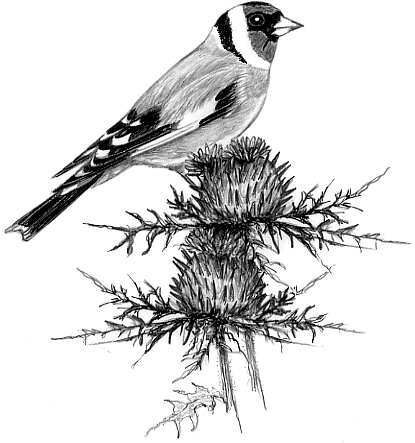
Dear Bird Folks,
I recently spotted a European Goldfinch on my feeder. First off, how unusual of a sighting is this? I thought these birds were native to Bermuda. Secondly, could the bird’s appearance have anything to do with the fact that my feeder contains seed from your store?
-Hannah, Braintree, MA
First off Hannah,
Of course the reason you had that unusual bird, or any bird, coming to your feeder is because you bought your seed from my shop. If you were to obtain your seed from any other source, you would never get a single bird and might end up with a rash or worse. And that’s the truth, or at least it is in my head.
Now for your suggestion that European Goldfinches are “native” to Bermuda, that’s a little wrong. As their name implies, the European Goldfinch comes from Europe. Bermuda, on the other hand, is off the coast of North Carolina. I’ll admit that Bermuda is clearly unlike anything you’ll see in North Carolina, but it really isn’t Europe either. European Goldfinches are no more native to Bermuda than hockey is native to Tampa Bay. Both are imports.
Bermuda has very few breeding birds and even fewer that are true natives. As many as two hundred different species of birds may be seen on migration, while only about twenty species actually breed there. Luckily for the visitors, the few birds that do nest on the island are a pretty splashy looking group. This group includes the Eastern Bluebird, Great Kiskadee, and the White-tailed Tropicbird. The White-tailed Tropicbird is known locally as the “longtail,” because the shorter name fits more easily on the necklaces that the local merchants like to sell to the tourists. The first time that I went to Bermuda, I was surprised how limited the birding was. Why would such a lush beautiful island have so few birds? The two most quoted reasons why are lack of diverse habitat and moped accidents. The birds refuse to wear those silly helmets and they pay the price.
The other colorful bird that nests in Bermuda is the aforementioned European Goldfinch. The European Goldfinch is a fine bird, although I have a little trouble with its name. The Europe part is accurate, but the gold part is a little misleading. You’ll find more gold in a ring purchased from a gum ball machine than you will see on this bird. If I was an American Goldfinch, I would sue them for misrepresenting the name gold. These birds from Europe have a bit of yellow on their wings and that’s about it. The real key field mark on this bird is its face. The European Goldfinch has a face that is half bright red and half bright white. It looks like a bird that fell asleep under a sun lamp before it could completely finish putting on sunscreen.
The people in Europe love their little finches. To show the birds how much they love them, they put them in cages. Goldfinches are fairly popular pet birds in many parts of the world. I’ve never understood this caged bird thing myself. To me it’s like seeing your kids playing outside and then making them come in. Who wants the noise and the mess in the living room? Birds and kids are both better off outside.
The European Goldfinch has been successfully transplanted to several parts of the world, including Australia and South America. Many attempts have been made to introduce it to North America but, with the exception of Bermuda, every one of them has failed. I’m not sure why it hasn’t been able to make it in North America, but it probably can’t handle the ridicule from the real goldfinch, the American Goldfinch. The non-gold European Goldfinch is too embarrassed to be seen on the same continent as the showy American Goldfinch. That might explain why it has such a red face.
Both finches enjoy the same habitat. They like weedy fields and eat mostly seeds. They both like thistle. That annoying thistle plant, that the people from Scotland are so in love with, is one of the bird’s favorite foods. As you know, with the American Goldfinch, it is just the male that has the flashy yellow plumage and that’s only in the summer. Both the male and the female of the imported goldfinch are colorful year round. In that sense, the European bird has it over our native gold finch, but I don’t like to admit that.
The bird that visited your yard, Hannah, is not from Bermuda or from some secret population that has emerged in Braintree. It most certainly is a bird that has escaped from somebody’s cage. Don’t worry about it being on the loose. It is much better off living out in the cold than being caged in a living room somewhere, with somebody’s noisy kids.